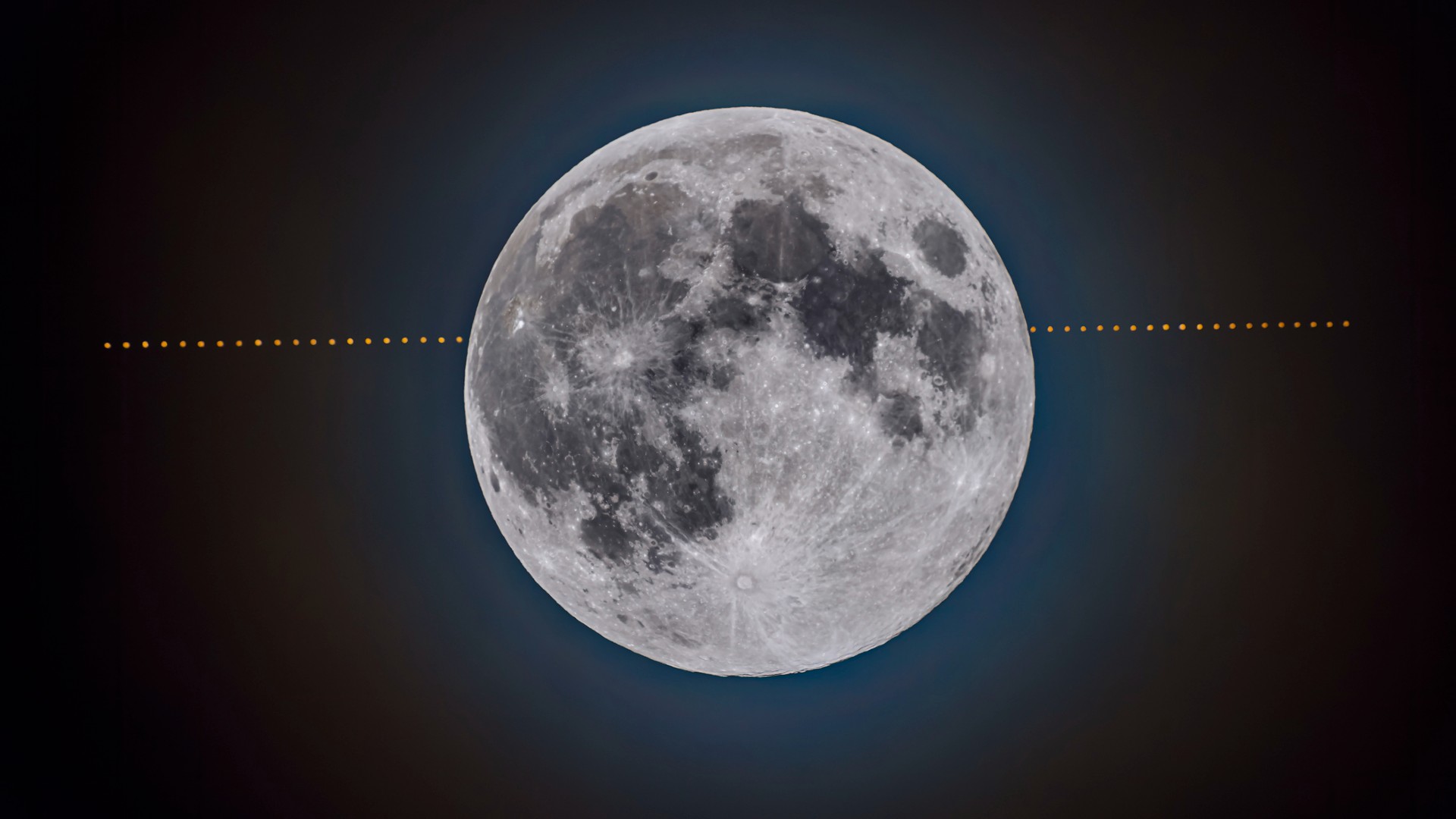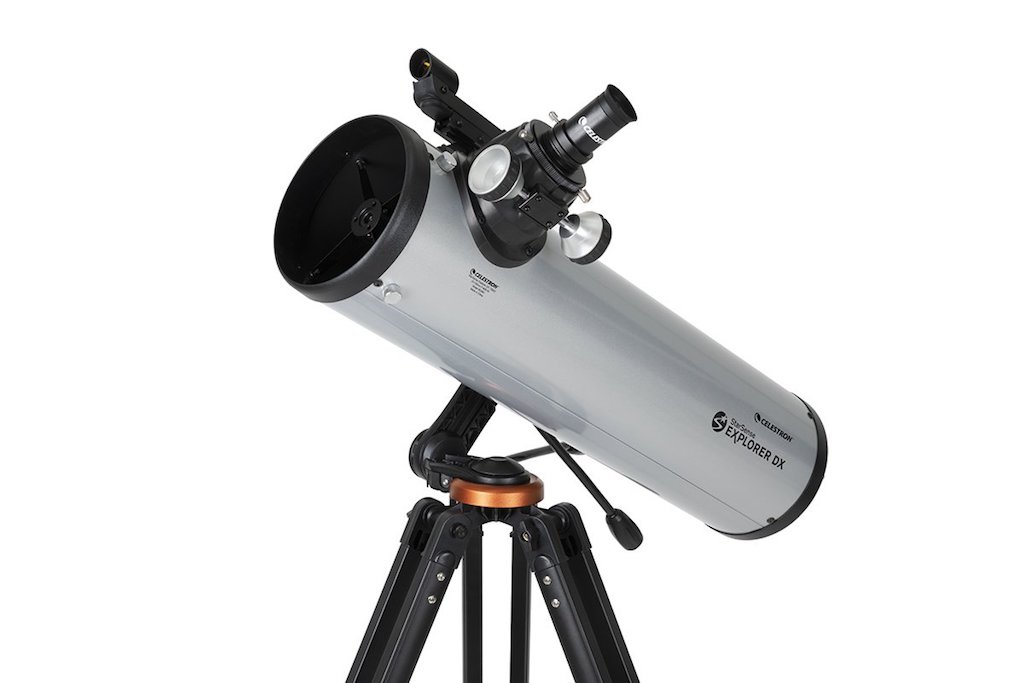
The first full moon of 2025 will pass in front of Mars, creating an event that will be visible from the continental United States, Mexico, Canada and western Africa.
The full moon of January, called the Wolf Moon, will occur at 5:22 p.m. EST (2227 UTC) on Jan. 13, according to the U.S. Naval Observatory. From New York City, moonrise is at 4:28 p.m. on Jan. 13. Sunset is at 4:51 p.m., so the moon will be visible for a short period during the day. According to the Astronomical League, the occultation of Mars will start at 9:21 p.m. local time, and Mars will emerge from behind the moon at 10:37 p.m.
The moon is called full when it is on the opposite side of Earth from the sun; the entire Earth-facing side is illuminated. The timing of the full phase depends on one's time zone, because it is measured according to the position of the moon rather than one's position on Earth. Full moons are so bright they cast visible shadows; in the Northern Hemisphere they are also higher in the sky in winter, making for bright, cold nights. In the Southern Hemisphere they will be lower, and often take on a yellower, larger appearance because the moon's light has to go through more of the atmosphere. Because foreground objects are more visible, there is an illusion that the moon looks bigger as there is something to give it scale (its angular size is actually unchanged).

Looking for a telescope for the next night sky event? We recommend the Celestron StarSense Explorer DX 130AZ as the top pick for basic astrophotography in our best beginner's telescope guide.
Lunar occultations aren't visible from the entire night side of Earth because the moon is close enough to the Earth that it can appear in a different position against the background stars.
As one observes the occultation, one will see the moon moving slowly eastwards – it will look as though Mars is "catching up" to the moon as they both appear to cross the sky. As the moon passes in front of the Red Planet the part of the moon it touches will depend on one's location on Earth; from New York it will appear to disappear behind the lower left (east) side, and emerge from the upper right.
The occultation in New York lasts for 1 hour and 16 minutes, which is about as long as it will last anywhere; the duration depends on one's location on Earth because the moon will appear further south against the background stars as one goes north, and further north as one moves south.
In Boston, the occultation starts at 9:26 p.m. local time and ends at 10:42, for a similar duration (it will differ by a few seconds). As one moves north Mars will pass in less time; for example in Montreal, using calculations from the Occult program (used by the International Occultation Timing Association) the Red Planet makes contact with the moon at 9:25 and emerges at 10:37 p.m. local time; the duration is slightly shorter.
Moving south, as in Miami, Mars will look as if it is just to the right on the "bottom" of the moon as it disappears at 9:30 p.m. local time, and it will emerge from the upper right side at 9:53 p.m. In Miami the sky is "rotated" so that the pathways of the two bodies appear to move more vertically, and the moon appears slightly more northward. That means Mars spends less time behind it.
Visible planets
Besides the occultation of Mars, other planets will accompany the moon in the sky that night; from New York City (and locations of similar latitude), early in the evening as the moon rises, Saturn and Venus will be in the western sky. Venus is bright and one of the first objects one can usually see as the sun sets. Just above and to the left of it will be Saturn, which will come out as the sun gets further below the horizon. In New York Venus sets first, at 8:48 p.m. and Saturn sets at 9:08 p.m.
In New York Jupiter rises on Jan. 13 at 1:41 p.m.; by 6 p.m. it is 47 degrees high in the east; it is bright enough that it will be just visible before the sky gets completely dark. The planet is visible most of the night, as it does not set until 4:25 a.m. Jan. 14.
From New York City, Mercury is lost in the solar glare; the planet rises at 6:20 a.m. local time, a bit more than an hour before the sun does at 7:18 a.m.; by the beginning of civil twilight at 6:48 the planet is only about 4 degrees high.

More southerly observers won't see the moon pass in front of Mars, but they will be better able to see Mercury, which will be at its highest altitudes close to the Equator, though it will still be difficult to see without an unobstructed horizon. From Quito, for example, Mercury rises at 5:10 a.m. local time on Jan. 13, while sunrise is at 6:19 a.m. At the start of civil twilight (5:57 a.m.) the planet is 10 degrees high in the east.
From the Southern Hemisphere, the nights are shorter as it is austral summer, but from Buenos Aires, Venus and Saturn are still in the west, and actually somewhat higher in the sky than in the Northern Hemisphere at sunset, which is at 8:09 p.m. on Jan. 13. By about 8:45 p.m. local time Venus is about 21 degrees high in the west, with Saturn appearing above it and to the right, about 4 degrees higher than Venus. Venus sets at 10:34 p.m. local time and Saturn at 10:52 p.m.
Jupiter, meanwhile, is 32 degrees high in the north-northwest by 9 p.m., and transits an hour later at 10:01 p.m. The planet sets at 3:04 a.m. local time.
Mars and the moon rise in Buenos Aires at 8:30 p.m. and 8:27 p.m., respectively, and will appear close together – within about two to three lunar diameters of each other.
Stars and constellations
In January the Northern Hemisphere skies are graced with some of the brightest constellations of the year, as well as the brightest star in the sky. Sirius, in Canis Major, rises in New York at 6:04 p.m. Eastern on Jan. 13; it is visible almost all night (the star sets at 4:09 a.m.). In locations of nearby latitudes such as Chicago, Sacramento, or Denver, the local rise and set times will be similar.
Sirius and Canis Major lie just south of Orion, which in mid-northern latitudes is well above the southeastern horizon — about 40 degrees — by 8 p.m. One will be able to see the three stars of Orion's Belt, making an upward diagonal line from east to west. The easternmost of the stars (on the left) is Alnitak, the central one is Alnilam, and the rightmost is Mintaka. Above Alnitak and slightly to the left is Betelgeuse, one of Orion's shoulders, and to the right of Betelgeuse is Bellatrix, which marks the other shoulder. Below the Belt one can see Saiph (also called Kappa Orionis) on the left and Rigel on the right; the two stars are the Hunter's feet.
Looking to the right of Orion and near Jupiter (which a that point is 67 degrees high in the mid-northern latitudes), one sees Aldebaran, the alpha star of Taurus, the Bull. Aldebaran can be distinguished from Jupiter as it is distinctly more orange and to the south of the planet (closer to the horizon). To the left of Jupiter – about twice as far from Jupiter as Aldebaran -- is a fainter star called Elnath, or Beta Tauri; it was once shared by Taurus and the neighboring constellation Auriga; modern astronomers place it in Taurus. North of Elnath is Capella, the alpha star of Auriga the Charioteer.
Looking south of Capella, near where the full moon and Mars are, one can see Castor and Pollux, the latter of which will be above and slightly left of the moon. Castor will be just above Pollux. Pollux may be hard to see as the moon will be very bright. Castor and Pollux are the two brightest stars in Gemini, the eponymous Twins, who sailed with Jason on the legendary ship Argo in Greek myths.
The Southern latitudes also have some famous constellations (and bright stars) during their summer months. From mid-southern latitudes (about where Buenos Aires, Cape Town and Melbourne are) by about 10 p.m. one can see the Southern Cross in the Southeast about 17 degrees high. Much closer to the horizon and more towards the south are Hadar and Rigil Kentaurus; they are to the right of the Cross and about 8 degrees above the horizon.
In the southeast, about 64 degrees above the horizon, one will see Canopus, or Alpha Carinae, the brightest star of the Keel, one of three constellations that make up Jason's ship Argo. Canopus is hard to miss as it is one of the brightest stars in the southern sky; rivalling Sirius in the Northern Hemisphere. Sirius is also visible in southern skies; it is a full 58 degrees high in the northeast.
Full moon names
The January full moon is often called the Wolf Moon, according to the Old Farmer's Almanac. The names of the moon in the U.S. are often a combination of terms settlers brought from Europe and those of local Native people; the term "Wolf Moon" is likely European. For northern Europeans the term "Yule" was originally in England a period of two lunar months starting in what is now December; January was called "Second Yule" in Old English. The term "Yuletide" is related to this though it is now conflated with Christmas.
In Hawai'i, the traditional lunar months start with the new moon; the full moon spans three days called Akua, Hoku, and Māhealani. The lunation that covers the month of January is Ka'elo.
In the American southwest, the Diné (Navajo) call the month of January – as measured from the new moon — Yas Nilt’ees. The name relates to melting the snow, which Diné people would do for water in winter because of the dry landscape they lived in.
In China, the full moon will fall in the 12th month of the traditional lunar calendar, Làyuè, or "Preserved Month" which refers to preserving foods for the spring festivals. In Vietnam, the 12th month of the lunar calendar, which is based on the Chinese one, is called Tháng Chạp.







